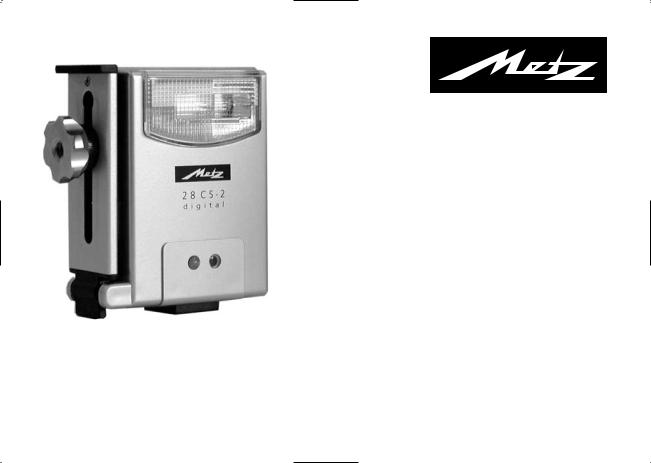Metz 28 CS-2 User Manual

MECABLITZ 28 CS-2 digital
Bedienungsanleitung |
Mode d’emploi |
Gebruiksaanwijzing |
Operating instruction |
Manuale istruzioni |
Manual de instrucciones |

Foreword
Congratulations on purchasing our
flash 28 CS-2 digital and thank you for the confidence in our products.
The following pages give useful instructions for proper operation of the flash unit and a survey of all its sophisticated functions.
Please read these operating instructions carefully, even if one or the other point may not appear to be very insteresting at first sight. Although our designers have attached great importance to making the operation of the flash unit as simple as possible, the cameras with which it will eventually be
used often offer a great diversity of capabilities.
Please also fold open the illustrated page at the end of these instructions.
We wish you great pleasure with this new flash unit.
Contents:
1. |
Safety instructions |
88 |
2. |
Preparations |
89 |
2.1 |
Power supply |
89 |
2.2 |
Loading and replacing the batteries |
89 |
2.3 |
Mounting / Removing the flash unit |
90 |
2.4 |
Switching the flash unit on and off |
90 |
3. |
Flash coverage and reflector attachments 90 |
|
4. |
Slave mode |
91 |
5. |
Switch on and shoot in EASY mode |
91 |
6. |
Slave modes (SL) |
93 |
6.1 |
Slave mode without preflash suppression |
94 |
6.2 |
Slave mode with preflash suppression |
95 |
6.3 |
Adapted slave mode |
95 |
7. |
Settings for camera and flash unit |
96 |
7.1 |
Cameras where operating mode, ISO |
|
|
and aperture can be set |
97 |
7.2 |
Cameras where operating mode, ISO |
|
|
and aperture cannot be set |
98 |
86

8. |
Flash modes |
99 |
|
8.1 |
Auto flash mode A |
99 |
|
8.2 |
Manual flash mode M |
100 |
|
8.3 |
Metz-Remote Flash Mode SL |
100 |
|
8.4 |
EASY Mode |
101 |
|
9. |
Flash parameters |
102 |
|
9.1 |
Automatic f-stop |
102 |
|
9.2 |
ISO speed |
102 |
|
9.3 |
Reflector status |
102 |
|
9.4 |
Flash exposure correction value EV |
103 |
|
9.5 |
Manual partial light output |
104 |
|
10. |
Displays |
104 |
|
10.1 |
Flash readiness indication |
104 |
|
10.2 |
Correct exposure confirmation |
104 |
|
10.3 |
Maximum flash range indication |
105 |
|
11. |
|
Special functions |
106 |
11.1 |
Automatic switch-off function / AUTO-OFF |
106 |
|
11.2 |
Meter-Feet changeover (m - ft) |
106 |
|
11.3 |
Adapting the flash delay in slave mode |
|
|
with preflash suppression |
106 |
11.4 |
Re-establishing the flash unit settings |
107 |
12.Troubleshooting, remedies and
after-sales service |
108 |
13. Technical data |
110 |
87

1. Safety instructions
•The flash unit is intended and approved only for photographical use.
•NEVER fire a flash from a very short distance directly into the eyes of persons or animals. This can cause damage to the retina and may even lead to blindness.
•NEVER trigger a flash in the vicinity of flammable gases or liquids (petrol, solvents, etc.), since this may cause EXPLOSIONS!
•NEVER shoot flash pictures of car or bus drivers, cyclists or motorcyclists, or train drivers while the vehicle is moving! This may dazzle the person
concerned and result in an accident.
•Only use the approved power sources specified in these operating instructions.
•NEVER attempt to open or short-circuit batteries!
•NEVER expose batteries to excessive temperatures such as intensive sunlight or a fire!
•Remove exhausted batteries immediately from the flash unit. Such batteries may leak, releasing chemicals which can damage the flash unit.
•NEVER attempt to recharge dry batteries!
•Do not expose the flash unit to dripping or splashing water.
•Do not expose your flash unit to high temperatures and humidity. Do not keep it in the glove compartment of your car.
•Do not touch the diffuser after firing several flashes at short intervals. Danger of burns!
•When taking flash shots at full light output and in rapid succession observe an interval of at least 3 minutes after 20 flashes.
•NEVER place material that is impervious to light in front of, or directly on the reflector. If this is not observed, the high energy of the flash light may cause burning or bleaching of the material or may damage the reflector.
•NEVER dismantle the flash unit! DANGER: HIGH VOLTAGE! Repairs must only be completed by an authorised repair service.
•Do not touch the contacts of the flash unit.
88

•The flash unit must not be used if the case has been so badly damaged that internal components are exposed. Remove the batteries!
•Do not use defective batteries!
2. Preparations
2.1 Power supply
The flash unit can be operated with any of the following batteries:
•2 alkaline-manganese dry-cell batteries, type IEC LR03 (size AAA). Maintenance-free power source for moderate power requirements.
•2 nickel-metal-hydride batteries, type IEC HR03 (size AAA). They have a significantly higher capacity than NiCad batteries and are less harmful to the environment (no cadmium). They permit very fast recycling and are economical in use because they are rechargeable.
•2 NiCad batteries, type IEC KR03 (size AAA).
The batteries are exhausted if the recycling time exceeds 60 seconds when firing flashes at full light output. Remove the batteries from
the flash unit if you are not going to use it for an extended period of time.
2.2 Loading and replacing the batteries
•Turn off the flash unit by its main switch.
•Slide the battery compartment cover to the outside of the flash unit.
•Insert the batteries as indicated by the symbols in the battery compartment.
When loading the batteries ensure that their + and - poles are aligned with the symbols. Transposed poles can destroy the flash unit.
Always exchange both batteries, replacing
them with identical batteries of the same capacity from the same manufacturer! Do not dispose of spent batteries in the domestic
waste bin. Spent batteries should be handed in to an appropriate collecting point.
•Close the battery compartment cover and slide it towards the unit’s foot.
89

2.3 Mounting / Removing the flash unit
Turn off the flash by their main switch!
Fold down the flash unit’s pivoted camera bracket. Secure the flash unit to the camera with the threaded tripod screw.
To dismantle release the threaded tripod screw and remove the flash unit from the camera. Push the camera bracket forwards at the hinge and simultaneously fold upwards.
2.4 Switching the flash unit on and off
To switch on set the main switch to “ON”. To switch off push the main switch down.
Automatic switch-off function / AUTO-OFF
To save battery power and prevent inadvertent battery discharge the flash unit is factory-set to switch over to standby mode (AUTO OFF) approx. 8 minutes after:
-switch-on,
-a setting procedure,
-firing a flash.
The flash readiness signal and the indications on
the LC display go out. After automatic switch-off the last used settings are retained and instantly available when the flash unit is switched on again.
The flash unit is reactivated merely by depression of any key (wake-up function).
The flash unit should always be turned off by its main switch if it is not going to be used for an extended period of time.
The automatic switch-off function can be deactivated whenever required (see Chapter 11.1).
3.Flash coverage and reflector attachments
If there is no attachment in front of the reflector, the flash unit provides full lighting coverage for normal 24x36 mm shots with lenses as of 35 mm focal length. If a wide-angle diffuser (identified by W) is used the flash will cover the image angle of a 24 mm lens. When positioning the telephoto attachment (identified by T) in front of the reflector the flash unit will fully illuminate shots taken with a telephoto lens of 85 mm focal length and longer.
90

Please note that the effective range of the flash light is diminished by using a wideangle diffuser, and increased with a telephoto attachment . For digital cameras take into account that the focal lengths are given for the 35 mm format (see operating instructions of the individual camera).
4.Slave mode
The slave mode is intended for cordless, delay-free triggering of one or more slave flash units. The slave is triggered by the light pulse from the flash unit built into the camera.
Some digital cameras fire one or more measuring preflashes a fraction of a second before flash exposure. Normally, these measuring preflashes cannot be deactivated on the camera because they do influence, for example, the flash exposure. Moreover, a preflash function can be activated on many cameras to diminish the “red eye effect”.
The internal photo cell sensor of the slave must be able to perfectly capture the light of the camera’s flash unit reflected by the sub-
ject so that it can be triggered. The working range of the assembly depends on the intensity of the light pulse from the camera-inte- grated flash, the reflective properties of the subject and the prevailing ambient light.
Please note that the working range is diminished outdoors and with bright ambient light. Avoid exposing the sensor to direct sunlight!
5. Switch on and shoot in EASY mode
The EASY mode permits easy use of the slave flash |
|
unit for flash photography. Auto aperture, ISO |
|
|
|
speed rating, etc. do not have to be set on the flash |
|
unit. |
|
The EASY mode is a simplified automatic flash |
|
mode intended for digital cameras without setting |
|
capabilities, or the “Program P” and full auto |
|
modes. |
|
Prior to its first use, the slave has to be adapted to |
|
the technology of the flash unit built into the came- |
|
ra to find out if the camera-integrated flash unit |
|
works with or without preflashes. |
|
91

Adapting the slave flash unit
•Activate the camera’s internal flash unit. If necessary, switch on the camera’s red-eye reducing preflash function.
•Turn on the slave flash unit by the main switch and wait for the flash readiness indicator  to light up.
to light up.
•Keep the “Mode” key on the flash unit depressed for approx. 5 s until the symbols 

 flash in an ascending sequence on the LC display. All other indications on the LC display and the flash readiness signal
flash in an ascending sequence on the LC display. All other indications on the LC display and the flash readiness signal  go out.
go out.
To terminate briefly depress the “Mode” key.
• Take a picture of an appropriate subject (e.g. wall or ceiling of a room) at a distance of 2 m to 3 m with the camera’s internal flash. With the aid of this shot the 28 CS-2 establishes the number of preflashes fired by the camera-integrated flash unit and automatically stores the data.
•The  flash readiness indicator on the flash unit briefly lights up again to confirm the completed adaptation.
flash readiness indicator on the flash unit briefly lights up again to confirm the completed adaptation.
•The LC display indicates the symbol “SL  ” for adapted slave mode, “EASY” flash mode and the maximum flash range (see Chapter 10.3).
” for adapted slave mode, “EASY” flash mode and the maximum flash range (see Chapter 10.3).
•The slave flash unit is now ready for operation.
Flash unit adaptation only has to be completed once because the stored settings are retained, even when the flash mode is changed, the flash unit is switched off and the batteries are replaced. Adaptation must be renewed when the settings of the camera’s flash unit, the preflash mode (e.g. red-eye reducing preflash ON / OFF) or the camera are changed.
The flash mode of cameras working with an automatically changing number of preflashes (e.g. Nikon 3D and D-TTL), as well as the Metz Remote Flash Mode, is not supported!
Test shots
Take some test shots with flash: The subject must be within the maximum flash range indicated on the LC display (see Chapter 10.3)! Assess the exposure results, e.g. on the camera monitor.
92

Depress the “+” key on the flash unit for a positive correction value when the flash shots are too dark, and the “-” key for a negative correction value when the flash shots are too bright. The correction value can be adjusted from +10 to -10. The setting becomes immediately effective and is automatically stored. The set correction value is taken over as the new zero value (“0”) for the next flash shot. Maximum flash range indication is adapted to the given correction value.
If the slave unit is not triggered repeat the flash unit adaptation procedure and take another test shot.
Tip:
Carefully read the next chapters of these Operating Instructions to be able to make full use of all the capabilities of this flash unit.
6. Slave modes (SL)
Selection of the slave mode suitable for your camera depends on the properties and technology of
the camera-integrated flash. The important point is to know whether the flash unit built into your camera works with or without measuring preflashes.
Selection of the slave mode determines whether the slave is triggered immediately after the first flash pulse from the camera’s flash unit, or whether one or more preflashes have to be suppressed before the slave is triggered together with the camera’s main flash.
Select one of the three different slave modes by |
|
|
repeated combined depression of the “MODE” |
|
|
and |
pre-select keys. The selected slave mode |
|
flashes on the LC display of the flash unit. |
|
|
Establishing the slave mode suitable for your |
|
|
camera |
|
|
It is not necessary to establish the suitable slave mode if you know whether or not your camera operates with preflash measuring technology!
Often it is rather difficult to establish whether or not a digital camera operates with preflash measuring technology. Proceed in the following manner to select the slave mode that is suitable for your camera:
93

•Activate the camera’s internal flash unit.
•Deactivate the red-eye reducing preflash function on the camera.
•Select on the slave unit the “M” flash mode with P 1/1 full light output (see Chapter 8.2).
•Then select the slave mode without preflash suppression on the slave unit (see Chapter 6.1).
•Take a test shot in which the reflector of the slave unit can be seen, for example in a mirror.
NEVER look directly into the flash unit’s reflector from a short distance as this could blind or injure your eyes!
• Assess the test shot, e.g. on the camera monitor.
•If the slave unit’s reflector is brilliantly illuminated in the test shot, then you have set the right slave mode for your camera.
•If the slave unit’s reflector is not bright or is dark on the test shot, then select on the slave unit a slave mode with preflash suppression (see Chapter 6.2) and take another test shot.
•If this still proves to be unsuccessful, then select the adapted slave mode. This enables you to
adapt the slave automatically to your camera’s flash function (see Chapter 6.3).
6.1Slave mode without preflash suppression SL 
This slave mode is suitable for all cameras working without measuring preflash technology. The slave is triggered at the same time as the flash unit incorporated in the camera. The light output of the slave is controlled by the selected flash mode (EASY, auto flash mode A or manual flash mode M).
If your camera has a red-eye reducing preflash function, this function must be switched off! Otherwise it may be accidentally activated by flashes of other photographers working within the same action radius as the slave flash unit .
Settings on the slave flash unit
Repeatedly depress the  pre-select and “MODE” keys simultaneously until the symbol SL
pre-select and “MODE” keys simultaneously until the symbol SL  flashes on the LC display. The setting instantly becomes effective and is automatically stored after 5 s.
flashes on the LC display. The setting instantly becomes effective and is automatically stored after 5 s.
94
